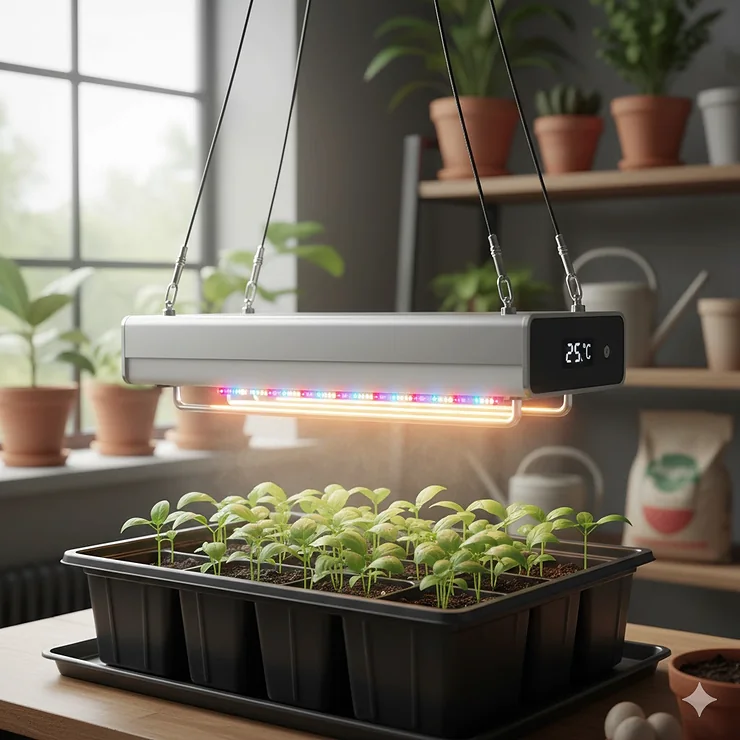In This Article
✨Was this helpful? Spread the word! 🚀
Starting seeds indoors can feel like gambling with Mother Nature—will they sprout, or won’t they? I’ve been there, staring at seed trays wondering why nothing’s happening while my neighbor’s seedlings are already three inches tall. Here’s the secret most home gardeners discover too late: temperature matters just as much as light. That’s exactly where a grow light heat light combo becomes your secret weapon for successful seed starting.

Think about it—seeds in nature germinate in warm soil under bright sunshine, not on your chilly basement shelf. A quality grow light heat light combo recreates those ideal conditions by combining full-spectrum lighting with consistent bottom heat, accelerating germination rates and producing stronger, healthier seedlings. Whether you’re starting tomatoes in February or propagating herbs year-round, these integrated systems eliminate guesswork and dramatically improve success rates compared to using either component alone.
The beauty of modern grow light heat light combo setups lies in their versatility. You’re not just buying two products that happen to work together—you’re investing in a coordinated ecosystem designed specifically for plant propagation. These all-in-one systems typically include seedling trays, humidity domes, adjustable grow lights with timer functions, and waterproof heat mats with precise temperature control. Everything works in harmony to create the perfect microclimate for your plants, from initial germination through the critical seedling stage.
Quick Comparison Table
| Product | Cells | Light Type | Heat Mat Size | Timer | Price Range |
|---|---|---|---|---|---|
| SOLIGT 60-Cell Complete Kit | 60 | Full Spectrum LED (11.5W) | Included | 3 Settings | $70-$90 |
| 72-Cell Multi-Mode System | 72 | 3 Light Modes | Standard 10×20″ | 4 Settings | $60-$80 |
| VIVOSUN 40-Cell Pro Setup | 40 | LED Light Bars | 10×20.75″ | Yes | $85-$105 |
| Jump Start 2ft System | 36 | T5 Fluorescent | 10×20″ | No | $90-$120 |
| MARS HYDRO VG80 Kit | Varies | 80W T5 LED (4ft) | 48×20″ | Optional | $180-$220 |
| Spider Farmer Pro Combo | 10×20.75″ | Separate Purchase | Digital Control | N/A | $40-$100 |
| Hugbow 80-Cell Deluxe | 80 (2-pack) | Full Spectrum | Included | Yes | $75-$95 |
💬 Just one click – help others make better buying decisions too!😊
🔍 Top 7 Grow Light Heat Light Combo Products: Expert Analysis
1. SOLIGT 60 Cell Seed Starter Kit with Grow Light and Heat Mat
This complete grow light heat light combo stands out as my top recommendation for beginners and experienced gardeners alike. The SOLIGT 60-Cell Kit delivers everything you need in one thoughtfully designed package that actually works.
Key Specifications:
- 11.5W full spectrum grow light (4500K) with 15 red and 111 white LEDs
- Waterproof heat mat with consistent warmth distribution
- 60-cell seedling tray with 4.3″ high humidity dome
- 5 brightness levels and 3 timer options (3h, 9h, 12h)
- Flexible 3-head gooseneck design for optimal positioning
Price Range: $75-$90
Customer feedback consistently highlights the reliable heat mat that provides consistent, even warmth for fast, healthy seed germination, with waterproof design ensuring durability and easy cleaning. Users particularly appreciate the flexibility of mounting the grow light with either the clip or stand attachment, making it versatile enough to use even after removing the humidity dome during later growth stages.
Pros:
✅ Complete all-in-one solution with no additional purchases needed
✅ Durable, thick plastic trays built for multiple growing seasons
✅ Excellent heat distribution prevents hot spots
Cons:
❌ Light intensity may be insufficient for larger, mature plants
❌ Timer must be reset if power is interrupted
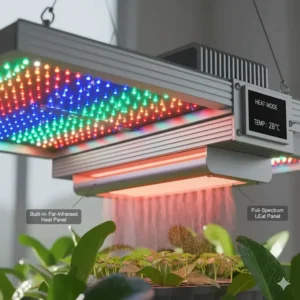
2. Seed Starter Trays with Grow Lights and Heat Mat (72-Cell System)
For gardeners who want maximum planting capacity in their grow light heat light combo, this 72-cell system offers impressive versatility with its three distinct lighting modes.
Key Specifications:
- 72 total cells across 6 separate 12-cell trays
- Triple lighting modes: white, blue+red, and combined spectrum
- Adjustable humidity control (50-100%)
- 4 timing options for automated care
- Waterproof seedling heat mat included
Price Range: $65-$85
The addition of blue and red light modes sets this apart—blue light inhibits leggy seedling growth while red light promotes stem and leaf development along with flowering and fruiting. This makes it particularly valuable if you’re growing a variety of plant types simultaneously, from herbs to flowering annuals.
Pros:
✅ High cell count maximizes growing space
✅ Multiple light modes optimize different growth stages
✅ Adjustable vents provide precise humidity control
Cons:
❌ More complex setup than simpler systems
❌ Six separate trays require more monitoring
3. VIVOSUN 40-Cell Seed Starter with LED Lights and Heat Mat
VIVOSUN has earned its reputation in the indoor growing community, and this 40-cell grow light heat light combo showcases exactly why. It’s professional-grade equipment at a consumer-friendly price point.
Key Specifications:
- 40-cell tray with 3.6″ higher cover for ample growth space
- Dedicated LED light bars providing additional supplemental lighting
- 10″x20.75″ seedling heat mat (0-120°F compatible)
- Dual digital display thermostat with precise temperature control
- Durable PET and PP material construction
Price Range: $90-$110
The crafted details shine through—LED light bars provide additional light to make plants stronger as they grow, while the black bottom promotes root growth and drainage holes prevent overwatering. The dual digital display thermostat deserves special mention; it allows users to set desired temperatures according to specific plant needs with simple, straightforward controls.
Pros:
✅ Professional-quality components and construction
✅ Precise temperature control via digital thermostat
✅ Compatible with various heating mat sizes
Cons:
❌ Higher price point than basic models
❌ Requires some technical knowledge for optimal thermostat use
4. Indoor Seed Starter Plus with Jump Start Grow Light System (2ft Kit)
Traditional T5 fluorescent technology meets modern seedling needs in this classic grow light heat light combo system that’s been trusted by gardeners for years.
Key Specifications:
- 2-foot T5 fluorescent grow light (6500K spectrum)
- Approximately 4,850 initial lumens output
- UL-listed 10″x20″ waterproof heat mat (17 watts)
- 6.5″ tall humidity dome included
- 36-cell seedling propagation tray with wonder soil wafers
Price Range: $95-$125
The included heat mat, wonder soil, and humidity dome get seedlings started quickly, while the grow light with one-touch height adjustability provides light when plants need it most. What sets this apart is its adjustable stand—as your seedlings grow taller, you can easily reposition the light to maintain optimal distance, preventing stretching and promoting compact, sturdy growth.
Pros:
✅ Tried-and-true T5 fluorescent technology
✅ One-touch height adjustment for growing plants
✅ Includes starter growing medium (wonder soil)
Cons:
❌ Fluorescent bulbs eventually need replacement
❌ Larger footprint than LED alternatives
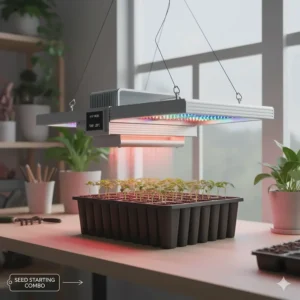
5. MARS HYDRO Seedling Cultivation Trio (VG80 80W Kit)
When you’re serious about seedling production and need commercial-grade reliability, the MARS HYDRO grow light heat light combo delivers professional performance that justifies its premium price.
Key Specifications:
- VG80 80W 4-foot LED T5 grow light system
- 48″x20″ large-format heat mat for maximum coverage
- Professional-grade seed starting trays included
- Energy-efficient LED technology
- Expandable system for larger operations
Price Range: $185-$225
This kit ensures robust, healthy plants with energy-efficient lighting, conducive heating, and spacious seeding trays designed specifically for optimal seedling growth. The 4-foot light bar provides exceptional coverage, eliminating the uneven growth patterns common with smaller lights. If you’re starting hundreds of seedlings or running a small commercial operation, this system scales beautifully.
Pros:
✅ Professional-grade equipment and performance
✅ Large coverage area for extensive seed starting
✅ Highly energy-efficient LED technology
Cons:
❌ Significant upfront investment required
❌ May be overkill for casual home gardeners
6. Spider Farmer Seedling Heat Mat Kit with Digital Thermostat
Spider Farmer brings precision temperature control to your grow light heat light combo setup with their highly-rated heat mat and thermostat system, designed to work seamlessly with any quality grow light you already own.
Key Specifications:
- Available in 10″x20.75″ and 48″x20.75″ sizes
- Digital heating mat thermostat controller included
- Waterproof construction for indoor use
- Temperature range: 32-104°F (0-40°C)
- Compatible with Spider Farmer grow lights and universal setups
Price Range: $40-$100 (depending on size and bundle)
Users report impressive germination success, with one gardener noting that their Malabar spinach seeds sprouted quickly after almost giving up, specifically recommending this for warm-weather crops like tomatoes, cucumbers, and okra. The separate digital thermostat might seem complicated initially, but it provides unprecedented control over soil temperature—the single most critical factor in germination success.
Pros:
✅ Excellent temperature precision and control
✅ Works with any quality grow light system
✅ Multiple size options available
Cons:
❌ Grow light sold separately
❌ Some users report uneven heat distribution in certain areas

7. Hugbow Self-Watering Seed Starter with Grow Light and Heat Mat (80-Cell, 2-Pack)
Rounding out our top picks, the Hugbow 80-Cell Deluxe System offers exceptional value with its self-watering design and generous 2-pack configuration—perfect for gardeners who need serious seedling capacity.
Key Specifications:
- 80 cells per tray (160 total cells in 2-pack)
- Self-watering system reduces daily maintenance
- Full spectrum LED grow lights included
- Heat mat with consistent temperature distribution
- Includes soil moisture meter for precision
Price Range: $80-$100
The self-watering feature transforms daily seedling care, automatically maintaining consistent moisture levels that prevent both overwatering and drought stress. Combined with the grow light heat light combo functionality, you’re looking at a nearly automated propagation system. Customer feedback emphasizes how the included 3-in-1 soil meter takes the guesswork out of knowing when to add water, making this particularly valuable for beginners.
Pros:
✅ Self-watering design reduces maintenance time
✅ High cell count with 2-pack value
✅ Includes soil moisture meter
Cons:
❌ Self-watering system requires initial learning curve
❌ Larger setup footprint than single-tray systems
✨ Ready to Supercharge Your Seedlings? 🌱
These carefully selected grow light heat light combo systems represent the best value and performance for 2025. Whether you’re starting your first seed tray or scaling up a commercial operation, there’s a perfect match here for your needs. Click any product name to check current availability and exclusive deals—your dream garden starts with healthy seedlings!
Understanding Grow Light Heat Light Combo Technology
The magic behind an effective grow light heat light combo lies in understanding how plants actually develop from seeds. It’s not just about warmth or light individually—it’s about their synchronized interaction.
How Bottom Heat Accelerates Germination
Seeds are remarkably temperature-sensitive. Most seeds require root zone temperatures between 75-80°F to germinate properly, which is significantly warmer than typical room temperature. This explains why seeds planted directly outdoors wait until soil warms in late spring. A quality heat mat in your grow light heat light combo creates this optimal environment artificially, essentially fast-forwarding spring by several weeks.
The heat stimulates enzymatic activity within dormant seeds, triggering the germination process. Think of it like wake-up coffee for seeds—without that warmth boost, they remain dormant regardless of moisture availability. Most heat mats warm the root area 10-20°F above ambient temperature, which perfectly aligns with the temperature range most vegetables and flowers need for successful sprouting.
Why Light Spectrum Matters
Once seeds germinate, light quality becomes paramount. Full-spectrum grow lights in modern grow light heat light combo systems mimic natural sunlight, providing the specific wavelengths plants use for photosynthesis. Blue wavelengths (400-500nm) encourage compact, sturdy growth and prevent the leggy, stretched seedlings that plague windowsill growers. Red wavelengths (600-700nm) drive photosynthesis and promote stem elongation and leaf expansion.
The photosynthesis process requires specific light energy to convert carbon dioxide and water into glucose and oxygen. Without adequate light intensity and proper spectrum, seedlings become weak and etiolated—that characteristic pale, spindly appearance that screams “I need more light!”
Choosing the Right Grow Light Heat Light Combo for Your Needs
Assess Your Growing Space
Before purchasing any grow light heat light combo, measure your available space carefully. Are you working with a basement shelf, a spare bedroom closet, or a dedicated greenhouse area? Larger systems like the MARS HYDRO 4-foot setup require significant real estate, while compact options like the SOLIGT 60-cell kit fit comfortably on standard shelving.
Consider vertical clearance too. Seedlings need 2-4 inches between the light source and foliage, and you’ll need space for the humidity dome during early germination. Factor in at least 12-18 inches of total vertical space for most systems.
Match Cell Count to Your Planting Volume
How many seedlings do you realistically need? Beginning vegetable gardeners might only require 20-30 plants total, making a 36-40 cell system perfect. However, if you’re supplying seedlings for a large garden, starting annuals for landscaping beds, or sharing starts with neighbors, those 72-80 cell systems suddenly make sense.
Here’s a rough guide:
- Small hobby garden (10×10′): 20-40 cells
- Medium vegetable garden (20×20′): 60-80 cells
- Large garden or multiple beds: 100+ cells
- Commercial production: Consider multiple large systems
Budget vs. Features Trade-offs
Entry-level grow light heat light combo systems start around $60-70, while professional setups exceed $200. What justifies the price difference? Higher-end systems typically offer:
💡 More precise temperature control with digital thermostats
💡 Stronger, more efficient LED grow lights with better spectrums
💡 Durable construction materials that last multiple seasons
💡 Advanced features like self-watering, multiple timer settings, and dimming
💡 Larger coverage areas and higher cell counts
For most home gardeners, mid-range options ($75-100) provide the best balance of features and value. They include all essential components without unnecessary bells and whistles.
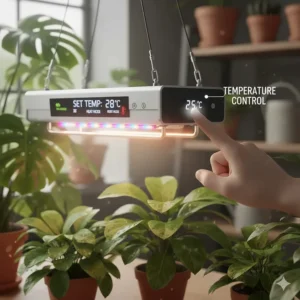
Setting Up Your Grow Light Heat Light Combo System
Initial Assembly and Placement
Most grow light heat light combo systems arrive partially assembled, requiring 15-30 minutes of setup. Start by selecting your location—ideally a spot with stable ambient temperatures (60-70°F works well), away from cold drafts or direct heating vents. According to EPA indoor air quality guidelines, maintaining consistent temperatures improves both germination rates and seedling health.
Place the heat mat on a flat, level surface. Avoid setting it directly on cold concrete; use a wood board or foam insulation underneath if necessary. Position the grow light frame or stand, ensuring it’s stable and won’t tip. The beauty of a coordinated grow light heat light combo is that everything’s designed to fit together—no improvising with mismatched components.
Optimal Temperature and Light Settings
Start your heat mat 24 hours before sowing seeds. This pre-warms the growing medium, creating ideal conditions immediately. For most vegetables and flowers, set your thermostat to 75-78°F. Heat mats should maintain temperatures in the optimal range to qualify as effective for seed starting and propagation.
Once seeds germinate and break soil surface, adjust your grow light height to 2-3 inches above emerging seedlings. Set timers for 14-16 hours daily—this mimics late spring day length and prevents stretching. As seedlings mature and develop true leaves, you can gradually reduce bottom heat while maintaining consistent lighting.
Moisture Management with Humidity Domes
The humidity dome included with most grow light heat light combo systems serves a critical purpose: maintaining consistent moisture during germination without constant watering. Initially, keep vents closed to maximize humidity. Once seeds sprout, crack vents slightly to increase air circulation and prevent fungal issues.
Water from the bottom by pouring into the reservoir tray rather than misting from above. This encourages downward root growth and prevents water from accumulating on leaves, which can cause damping-off disease under humid conditions. The self-watering systems in premium grow light heat light combo units automate this process beautifully.
Common Mistakes to Avoid
Overheating Your Seedlings
Yes, you can have too much of a good thing! Some grow light systems warn against using heat mats simultaneously with certain lights, as the combination can overheat and dry out tender seedling roots. This is particularly relevant if you’re combining components from different manufacturers.
Monitor soil temperature with a dedicated thermometer—don’t just trust the heat mat’s built-in settings. If soil exceeds 85°F, your seedlings may cook rather than thrive. Adjust accordingly by lowering heat mat settings or increasing light distance to reduce radiant heat.
Inadequate Light Intensity or Duration
A weak or improperly positioned light defeats half the purpose of your grow light heat light combo investment. Seedlings stretching toward light with pale, elongated stems signal insufficient illumination. Position lights closer (but not touching the dome) and verify your timer maintains 14-16 hour photoperiods consistently.
Don’t make the mistake I did early on—placing your system near a window thinking “bonus natural light!” Fluctuating natural light confuses seedling development and introduces temperature swings that undermine your controlled environment. Choose a location away from windows for best results.
Neglecting Gradual Hardening Off
Your grow light heat light combo creates a perfect, pampered environment—perhaps too perfect. Before transplanting seedlings outdoors, they need gradual acclimation to real-world conditions. Start by reducing heat mat temperature over 3-4 days, then expose seedlings to outdoor conditions for increasing periods (1 hour, then 2, then 4, etc.) over a week.
Plants raised entirely under artificial conditions can suffer severe shock when suddenly thrust into full sun, wind, and temperature fluctuations. This “hardening off” process ensures your carefully nurtured seedlings survive and thrive after transplanting.
Grow Light Heat Light Combo vs. Traditional Methods
| Factor | Grow Light Heat Light Combo | Windowsill Method | Greenhouse |
|---|---|---|---|
| Germination Speed | Fast (7-10 days typical) | Slow (14-21 days) | Fast (weather-dependent) |
| Equipment Cost | $60-$220 | Free-$20 | $200-$5,000+ |
| Seedling Quality | Excellent (stocky, strong) | Variable (often leggy) | Excellent |
| Space Efficiency | High (vertical stacking) | Low (horizontal only) | High |
| Climate Control | Precise and consistent | None | Moderate to excellent |
| Energy Use | Low ($5-15/month) | Minimal | Moderate to high |
| Learning Curve | Moderate | Easy | Moderate to difficult |
The integrated grow light heat light combo approach delivers professional-quality results without requiring greenhouse investment or dealing with unpredictable windowsill conditions. You’re essentially creating a miniature greenhouse with precision climate control—all in a space no larger than a kitchen countertop.
Maintenance and Troubleshooting
Cleaning and Sanitizing Between Uses
After each growing cycle, thoroughly clean all components of your grow light heat light combo system. Soak plastic trays and domes in a 10% bleach solution for 10 minutes, then rinse completely. This prevents disease transmission between planting sessions.
Wipe heat mats with a damp cloth—never submerge them even if labeled waterproof. Check electrical connections for wear or damage. LED grow lights typically require only occasional dusting, but check for any loose connections or damaged cords. Proper maintenance extends your system’s lifespan significantly, making that initial investment pay dividends over many growing seasons.
Diagnosing Common Problems
Seeds not germinating: Verify soil temperature with a separate thermometer. Heat mats can fail or thermostat sensors can drift. Confirm the mat feels warm to touch—not hot, but noticeably warm.
Leggy, stretched seedlings: Insufficient light intensity or duration. Lower grow lights to 2-3 inches above plants and verify timer settings. Consider upgrading to more powerful LEDs if consistently seeing this issue.
Damping off (seedlings collapsing at soil line): Excessive moisture and poor air circulation. Open humidity dome vents wider, reduce watering frequency, and increase air movement with a small fan. This fungal condition spreads rapidly in stagnant, humid environments.
Uneven germination: Heat mats with hot spots cause this. Rotate trays 180° daily to equalize exposure. Consider adding a layer of cardboard or thin wood beneath the mat to diffuse heat more evenly.

Advanced Growing Techniques
Microgreen Production with Grow Light Heat Light Combo
Your grow light heat light combo system isn’t just for transplant starts—it’s perfect for high-value microgreen production. Popular varieties like radish, sunflower, and pea shoots thrive under these conditions, reaching harvest size in just 7-14 days. The consistent warmth accelerates growth while preventing the mold issues that plague microgreen growers.
Seed microgreens densely (unlike transplants that need spacing), maintain high humidity initially, then increase ventilation once sprouted. The synchronized light and heat create optimal growing conditions that justify microgreens’ premium price at farmers markets.
Extending Growing Seasons Year-Round
Why limit your grow light heat light combo to spring seedling production? Use it year-round for continuous harvests of lettuce, herbs, and leafy greens. In winter, start cool-season crops indoors for transplanting to cold frames. In summer, get a jump on fall crops by starting broccoli, cabbage, and cauliflower in climate-controlled comfort while outdoor temps still soar.
The National Gardening Association emphasizes season extension techniques as key to maximizing garden productivity. Your grow light heat light combo serves as the cornerstone of a true four-season gardening strategy.
Propagating Cuttings and Clones
Beyond seed starting, these systems excel at rooting plant cuttings. Bottom heat significantly improves rooting success rates for plant propagation and cloning, with users reporting excellent results even for challenging species. Herbs, houseplants, and perennial flowers root faster and more reliably with the warmth and controlled environment your system provides.
Prepare cuttings by removing lower leaves, dip in rooting hormone, and insert into moistened growing medium. The humidity dome maintains perfect moisture around cuttings while they develop roots, and the bottom heat accelerates the rooting process that might otherwise take weeks.
Energy Efficiency and Operating Costs
One common question about grow light heat light combo systems: “Will this spike my electric bill?” Let’s break down actual costs. A typical 60-80 watt LED grow light running 16 hours daily consumes about 1.3 kWh daily. At the U.S. average of $0.14/kWh, that’s roughly $0.18 per day or $5.40 monthly.
Heat mats typically draw 17-45 watts depending on size. Running continuously (though you’ll reduce heat after germination), a 20-watt mat costs about $0.07 daily or $2.10 monthly. Combined, you’re looking at $7.50-10 monthly to operate your complete grow light heat light combo system—far less than the cost of purchasing equivalent transplants at retail.
Modern LED technology makes these systems remarkably efficient. Compare this to older fluorescent setups that consumed 2-3 times more power for similar light output. Your investment in a quality grow light heat light combo pays for itself within 1-2 seasons through reduced transplant purchases and lower energy consumption versus older technologies.
Seasonal Optimization Strategies
Spring Seedling Production
Prime time for your grow light heat light combo! Begin 6-8 weeks before your last frost date for tomatoes, peppers, and eggplants. Start cool-season crops like lettuce, broccoli, and cabbage even earlier. The consistent environment guarantees strong transplants ready the moment soil warms.
Track your local frost dates through USDA Plant Hardiness Zone maps and count backward. Mark your calendar for succession planting—starting new batches every 2-3 weeks ensures continuous supplies of fresh transplants throughout spring.
Fall and Winter Indoor Production
As outdoor gardens wind down, shift your grow light heat light combo to productive food growing rather than just transplant production. Leafy greens, herbs, and microgreens thrive under these conditions without requiring transplanting. Basil, cilantro, lettuce, arugula, and spinach produce fresh harvests all winter, dramatically reducing grocery bills for these high-cost items.
Reduce heat mat usage during this phase unless growing particularly heat-loving herbs like basil. Many leafy greens actually prefer cooler root temperatures (60-70°F), conserving energy while maintaining production. Your grow light remains critical, however, as winter’s reduced day length and weak sun make supplemental lighting essential.
Summer Hardening and Fall Crop Starts
Midsummer brings opportunity to start fall crops in climate-controlled comfort. Brussels sprouts, kale, and other cold-hardy vegetables need starting during July’s heat—nearly impossible without controlled conditions. Your grow light heat light combo solves this by creating spring-like conditions indoors while outdoor temps soar into the 90s.
Use this period also for rooting perennial cuttings and starting biennial flowers for next year. The system’s versatility shines when you realize it supports every phase of a comprehensive gardening calendar.
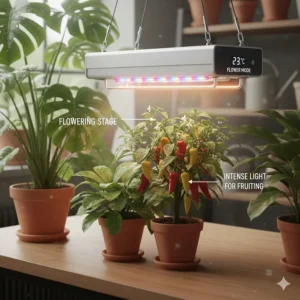
Frequently Asked Questions
❓ Can I use a grow light heat light combo for houseplant propagation?
❓ How long before I need to replace components in my grow light heat light combo system?
❓ What's the ideal distance between the grow light and seedling trays?
❓ Do I need different settings for vegetables versus flowers in a grow light heat light combo?
❓ Can a grow light heat light combo work in an unheated garage or basement?
Conclusion
Investing in a quality grow light heat light combo transforms seedling production from frustrating guesswork into predictable success. Whether you’re starting your first tomato seedlings or running a small plant business, the synchronized combination of bottom heat and optimal lighting delivers results that justify every dollar spent.
The seven systems reviewed here represent the best options currently available, each suited to different needs and budgets. The SOLIGT 60-Cell Kit offers outstanding all-around value for home gardeners, while the MARS HYDRO setup delivers commercial-grade performance for serious growers. Budget-conscious beginners will appreciate the 72-Cell System’s versatility, and the VIVOSUN options provide professional quality at mid-range prices.
Remember, successful gardening isn’t about luck—it’s about creating optimal conditions consistently. Your grow light heat light combo system delivers precisely those conditions, taking the uncertainty out of seed starting while producing stronger, healthier plants than traditional windowsill or outdoor methods. The initial investment pays dividends immediately through improved germination rates, stockier seedlings, and the flexibility to start seeds exactly when your schedule demands rather than when weather cooperates.
🌟 Start Growing Like a Pro Today!
Don’t let another growing season pass with mediocre seedlings and disappointing germination rates. Choose the grow light heat light combo system that matches your needs, set it up following the guidance here, and prepare to be amazed at the difference synchronized heat and light makes. Your future self—standing in a garden full of thriving plants—will thank you for making this smart investment now!
Recommended for You
- Pendant Grow Light: 7 Best Picks Transform Indoor Gardens
- Top 7 Grow Light Shelves for Thriving Indoor Plants in 2025 | Expert Guide
- Grow Light Timer: 7 Best Options + Expert Guide 2025
Disclaimer: This article contains affiliate links. If you purchase products through these links, we may earn a small commission at no additional cost to you.
✨ Found this helpful? Share it with your friends! 💬🤗

